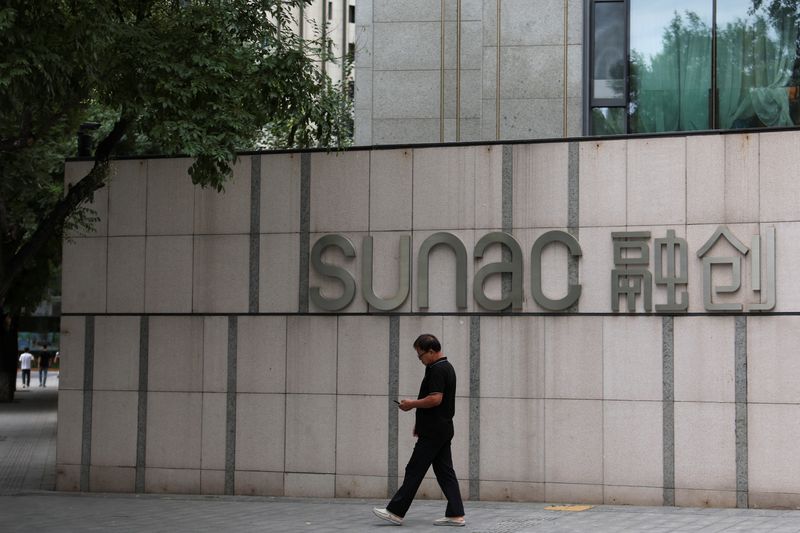By Clare Jim
HONG KONG (Reuters) – Progress by Chinese language property developer Sunac in direction of a landmark restructuring deal for yuan bonds may open the gates to a flurry of debt agreements subsequent 12 months, because the sector provides up on returning to monetary well being anytime quickly.
Hit with a liquidity disaster since 2021, China’s extremely indebted builders started tackling the restructuring of offshore bonds in 2022. However for politically delicate onshore bonds, they’ve repeatedly prolonged maturities, pinning their hopes on a pickup in cashflow.
That observe now not appears viable given the extended weak point in housing demand and the broader financial system, business officers and analysts say.
Logan Group plans to restructure all of its onshore bonds in 2025, stated an individual briefed by the corporate. The Shenzhen-based actual property growth agency faces repayments of two.4 billion yuan ($330 million) subsequent 12 months, in keeping with LSEG information.
It goals to begin discussions with bondholders in January and achieve approval in March, the individual stated, including that the proposal will ask bondholders to take enormous losses.
Shanghai-based CIFI Holdings, a big property developer as a consequence of repay bondholders 3.1 billion yuan in 2025, can be contemplating a debt revamp, a separate supply briefed by CIFI stated. However a lot would depend upon whether or not Sunac is profitable in securing a deal, the supply added.
The sources weren’t authorised to talk to the media and declined to be recognized. Logan and CIFI didn’t reply to Reuters requests for remark.
The 2 are amongst many builders with bond funds due subsequent 12 months. For instance, embattled Nation Backyard (HK:), the nation’s No. 2 non-public property developer, is predicted to repay onshore collectors 6.6 billion yuan subsequent 12 months. Nation Backyard, primarily based in Guangdong province, declined to touch upon its debt compensation plans.
Although authorities have sought to bolster the sector with a variety of measures reminiscent of slicing mortgage charges and minimal down-payment ratios, fundamentals for many builders haven’t modified a lot previously three years.
“There’s no new liquidity and no new lending and sales haven’t improved,” stated Glen Ho, nationwide turnaround & restructuring chief at Deloitte.
“The focus for 2025 will be onshore debt restructuring,” he added.
SUNAC – THE LITMUS TEST
Beijing-based Sunac has stated it plans to chop $2.1 billion value of onshore bond debt by greater than half. Final week it secured adequate help from bondholders for 2 of the ten bonds it goals to restructure, a supply has stated.
However Sunac might want to achieve adequate approval from holders of all 10 bonds for the deal to maneuver forward. The voting deadline for the opposite eight has been delayed until Dec. 23 and if Sunac is profitable, it is going to mark the primary company-led restructuring of yuan debt with steep haircuts within the property sector.
“I don’t think it’s going to be easy for Sunac to get all bondholders to sign off on the deal,” stated a senior govt at a property developer who declined to be named due to the sensitivity of the problem. “Every developer is watching. If it manages to cut debt, we’ll want to do it too.”
Foreky Wong, founding companion of advisory agency Fortune Ark Restructuring, stated Sunac’s proposal to bondholders suggests authorities are now not towards onshore collectors taking up a few of the property builders’ ache.
“It shows onshore creditors will also need to help the sector’s deleveraging by taking losses,” he stated.
The Chinese language Securities Regulatory Fee didn’t reply to a request for remark.
Chinese language actual property builders had complete liabilities of roughly $12 trillion in 2023, in keeping with an estimate by China’s Nationwide Bureau of Statistics. That determine consists of every kind of debt together with loans, belief and payables, in addition to onshore and offshore liabilities.

On the whole, the property sector has extra onshore debt than offshore debt. Onshore debt tends to be held by a variety of buyers from state insurers to non-public asset managers.
($1 = 7.2816 )




